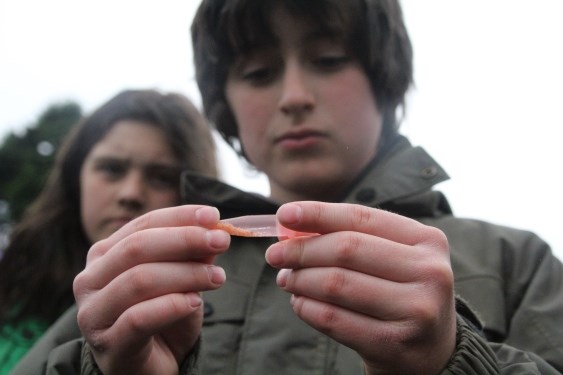On Thursday morning, when Bowen Belle water taxi pulled in to English Bay to drop commuters off at Granville Island, English Bay Launch owner and operator Mike Shannon says he didn’t see anything that indicated that there might be a problem in the water.
“There were Coast Guard boats out, but they do drills fairly regularly, so I figured that was what was happening,” says Shannon. “I couldn’t actually see an oil slick at that point.”
For biologist Ramona DeGraaf, what the average person cannot see in spill-affected waters and beaches is of primary concern. DeGraaf, who was on Bowen conducting a shoreline survey in October, says that the embryo of forage fish that spawn on the shores of English Bay will suffocate and die if the gravelly beaches where they lay their eggs are contaminated with oil.
“When I talk about forage fish, I am talking about a very specific group of fish that run the marine food chain – herring, surf smelt, sand lance – without these, the whole Straight of Georgia ecosystem is at risk. A reduction in the biomass of these fish is going to have a major impact on all predators, and that includes killer whales,” says DeGraaf. “And English Bay is super-smelt land.”
She says that this time of year, there are surf smelt embryos in the beaches, larvae feeding in the water, and adults coming into Burrard Inlet and English Bay to spawn.
“Right now, and for however many years that oil is going to be caught in the sediment of those beaches, any embryo deposited is going to suffocate. Even micro-amounts of oil will cause the effect similar to covering your head in a plastic bag full of fumes.”
She adds that the shoreline of the Lower Mainland used to be prime spawning habitat for surf smelt and sand lance, but most of it has been destroyed by sea walls and marinas.
“Discovering a beach that is intact and suitable for spawning is so rare, it’s like finding dinosaur bones,” says DeGraaf. “But in my shoreline surveys I’ve found good spawning beaches around Dundarave Pier, John Lawson Creek, Totem Beach in Stanley Park and Rec Beach. I am just so glad that at least that there are good spawning grounds up on the Sunshine Coast and near Powell River that should be safe from damage.”
Starting this Friday, De Graaf is going to conduct an initial assessment of the impacts of any hydrocarbons at the beach at Sandy Cove, which has been identified as an important smelt spawning site. From there, she says she will decide where to go in order to expand her study on the toxicity rates within smelt embryos on affected beaches.
“I am trying to be hopeful that I’ll find the level of contamination in the beach sediment to be low,” says DeGraaf. “But when you look at that oil sheen on the surface, and if we get some high winds come in, that will likely do the job of mixing it in with the sediment.”
Bowen Islander Karen Wristen, executive director of the Living Oceans Society, shares DeGraaf’s concerns about the long-term and less visible impacts of this oil spill.
“This weekend, I went down to Seymour Bay and Arbutus Cove because I thought that if oil were to wash up anywhere on Bowen’s shoreline, it would likely be there,” says Wristen. “I didn’t see any evidence of oil, but as I watched the herons feeding, I thought about the impact a contaminated population of fish is likely to have on our local heron population.”
Wristen adds that recent research conducted for the Living Oceans Society by Dr. Jeffrey Short, a chemist who worked for the US government assessing damage to caused by the Exxon Valdez oil spill, shows that oil is deadly to virtually all fish while they are in their larval forms.
“Certain compounds in bitumen or bunker oil can dissolve into water and then be absorbed by the translucent embryos,” says Wristen. “When exposed to sunlight, these compounds promote the oxidization of tissues within the embryos – in effect, burning them. This effect was demonstrated in herring embryos on the shorelines of San Francisco Bay after the 2009 Cosco Busan oil spill.”
Wristen says that the wider impacts of the oil spill in English Bay may be difficult to monitor, but doing so is crucial.
“If we don’t start doing it immediately, we won’t have any hope of linking the cause and effect of this in the future,” she says.
The report Wristen sites when discussing fish embryos and oil was written for submission to the Kinder Morgan pipeline hearings, and focuses largely on oil spill response-preparedness.
“This event shows the risks, and that really, there is no intention on the part of the Coast Guard to address them,” says Wristen. “They’re saying that 80% of the spill has been picked up, when really, the International Tanker Owners Pollution Fund, which regularly publishes statistics, shows that only 15 percent of a spill is ever picked up. Furthermore, even in the sailor who first reported this spill says that he could see the oil sinking right away.”
She adds that the prospect of cleaning up oil from affected shorelines is grim.
“On the coastline up in Prince William Sound where the Exxon Valdez spilled, there is an estimated 80 thousand litres of oil remaining in the cobble beaches. There is no method proven to be particularly effective of getting oil off of rocks and out of fine sediment,” says Wristen. “You’ve likely heard descriptions of the oil on the shores of English Bay as being like bubblegum. It will take a long time for the elements to break this down and for those beaches to recover.”



